Button Wrinklewort
Button WrinklewortRutidosis leptorrhynchoides | |
|---|---|
| Kingdom: | Plantae |
| Phylum: | Magnoliophyta (Angiosperm) |
| Class: | Magnoliosida (Dicotyledon) |
| Order: | Asterales |
| Family: | Asteraceae |
| Status | |
| Australia: | Endangered (EPBC Act 1999) |
| Victoria: | Endangered (FFG Threatened List 2025) |
| FFG: | Listed, Action Statement No. 28 (pdf) |
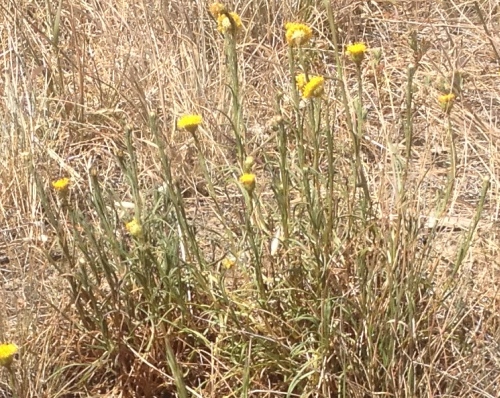
The Button Wrinklewort (Rutidosis leptorrhynchoides) is a perennial herb and member of the daisy family. It is only found in southeastern Australia and was probably once widespread on the grasslands and grassy woodlands of southeastern New South Wales to areas south of Great Dividing Range in Victoria. Now it is only confined to about 27 recognised populations1 in two main areas of southeastern Australia, these being areas west of Port Phillip Bay, Victoria (8 southern populations) and the Goulburn and Queanbeyan area of New South Wales and adjoining areas in the Australian Capital Territory (19 northern populations).
Button Wrinklewort is a tufted, single or sparsely stemmed herb to 30cm tall. Stems are glabrous, supporting a yellow flower during summer, leaves are linear to 40mm in length by up to 1.5mm wide. The yellow flower heads consist of numerous tiny flowers clustered together and surrounded at the base by overlapping, wrinkled, dull greenish bracts to form a button flower which can be 8-20mm across (Walsh & Entwisle 1999, FIS 2005).
Distribution
In Victoria, almost all of the remaining populations are located within the Victorian Volcanic Plains bioregion, although there are isolated records form the Dundas Tablelands and Goldfields bioregion. It is now absent from the Gippsland Plain bioregion (FIS 2005).
In Victoria, 18 locations are identified by the Department of Energy, Environment and Climate Action (DEECA) as requiring conservation management, these sites are almost entirely confined to public land of various status such as roadside reserves, rail reserves, cemetery reserves and some in designated nature reserves. A common feature of these areas is that they have been subject to little or no disturbance from intensive agricultural activities and any new discoveries of this species on private land would most likely be confined to similar undisturbed areas.
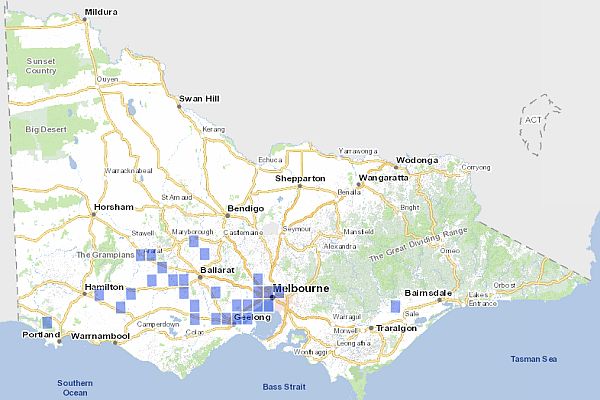
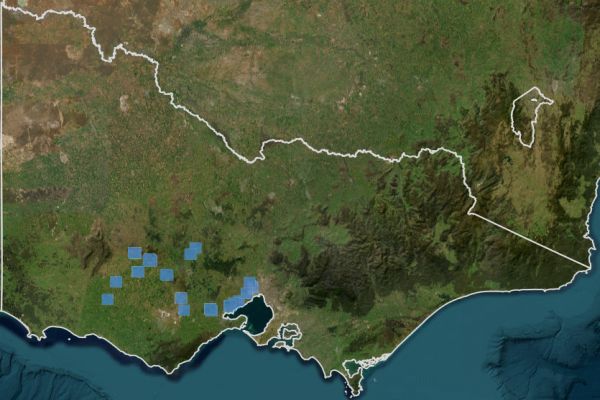
Ecology & Habitat
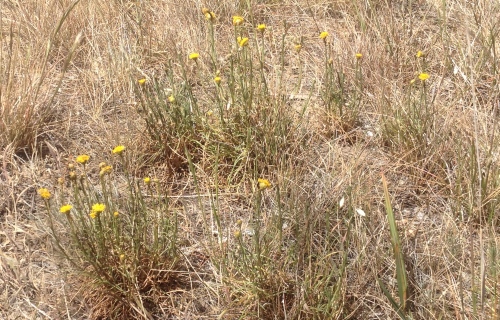
(Themeda triandra) on plains grassland, and grassy woodlands.
Image: A. Arnold
Button Wrinklewort is associated with Kangaroo Grass Themeda triandra on plains grassland, and grassy woodlands ranging from fertile red-brown clay loams to shallow and stony rises. Plants are usually in areas where the grass cover is more open either as a result of recurrent fires or on low rises with shallow, stony soils often in the higher parts of the terrain and where the moisture status in summer is low and associated herbs and grasses are typically sparse (Morgan 1995a).
Button Wrinklewort has a high genetic variation compared to other plant species, chromosome analysis of 19 of the 24 known populations in 2001 identified 17 different chromosome variants or cytotypes (Murray & Young 2001). Populations are generally either diploid (i.e. plants have 22 chromosomes) or tetraploid (i.e. plants having 44 chromosomes). Northern populations (NSW & ACT) are primarily diploid, whereas those in the south (Victoria) are either wholly diploid, wholly autotetraploid, or mixed (Young et al 1999).
Flowering usually takes place in the second year (Briggs et al. 1998). In Victoria, flowering occurs from October to January, peaking in November and December (Morgan 1999). Button Wrinklewort is not self pollinating and requires insects such as scarab beetles, flies and moths to achieve pollination. Seed set may be limited by pollinators where plants are sparse and populations are large (Morgan 1995a). There is strong evidence that population density, not population size, influence seed set, plants located in close proximity to one another (<0.5m) may be able to affect some wind-pollination between near neighbours, also pollinator visitation rates may decline in low-density populations or pollinators may be less efficient in these circumstances (Morgan & Scacco 2006).
Seeds do not last for more than one season with germinable seed present in the soil only during the period prior to the autumn break, beyond this time most seeds simply rot in moist soil or are predated by soil invertebrates (Morgan 1995a).
Life span is estimated to be 10-15 years with some plants possibly surviving 20 to 30 years (Morgan 1999), The longevity of individual plants would be influenced by factors such as physical disturbance, grazing, competition from other grassland or weed species and availability of water and light. Burning is likely to have a positive influence by preventing overcrowding from other species.
Reintroduction of Button Wrinklewort has been successfully undertaken by propagating seed and planting out into suitable habitat. Plantings at Mooramong Nature Reserve and Middle Creek Bushland Reserve in western Victoria have produced populations with the potential to function in a manner that is demographically similar to the natural remnant populations (Morgon 2000).
Population Status
Button Wrinklewort growing in low numbers and low density are at risk, studies have determined the reproductive capacity of populations numbering less than 20 flowering plants may be limited (Young et al. 1999). The reproductive success of small and patchy populations is magnified not only because of reduced opportunity for pollination but also because of the limited life of viable seed. If seeds do not germinate in the year they are produced it may lead to a gradual decline in the overall population as senescent plants are not replaced with new stock. Over time the species will be incapable of future re-establishment regardless of whether conditions are appropriate because there will be no seed in the soil from which to recruit (Morgon 1995a).
Larger populations of Button Wrinklewort have the most genetic variation and are therefore considered to be high priority for conservation of the species. Populations less than 20 plants have low genetic variation, Young et al. 1999 consider their viability may be limited. Whist small populations maintain some capacity for natural regeneration they also are valuable for conservation and prove valuable for possible re-introduction.
In order to ensure there are no unintended consequences from reintroduction programs regarding dysgenic effects, future re-establishment efforts for this species should avoid mixing seed from different chromosome races (Murray et al. 2001)
Threats
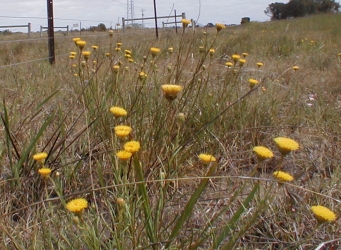
Button Wrinklewort in grassland with
Chocolate Lily (Arthropodium strictum)
which are the larger leaves in foreground.
Images: Donna Burns
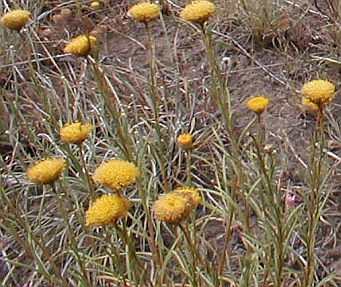
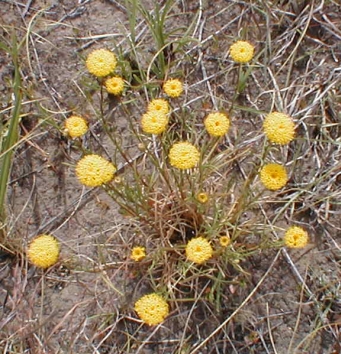
Weed invasion
There are several weed species which are a threat to various Button Wrinklewort sites in Victoria eg. Phalaris aquatica, Paspalum Dactylis glomeratus, African Lovegrass Eragrostis curvula, Chilean Needlegrass Nassella neesiana and Serrated Tussock Nasella. trichotoma, Montpellier Broom Genista monspessulana, Smilax, Fennel Foeniculum vulgare, Cotoneaster Cotoneaster glaucophyllus, and Gorse Ulex europaeus.
Weed invasion results in loss of suitable habitat by depriving Button Wrinklewort of light, moisture and suitable microhabitat for seed germination. Weed invasion of grasslands is made worse in areas of soil disturbance or through lack of burning which results in dominance of weeds. Disturbance factors and influences on grasslands were studied by (McIntyre & Lavorel 1994), they concluded occurrence of exotic species was associated with higher levels of disturbance, environmental variation mostly resulted in species substitutions while disturbances led to losses of species, with partial replacement by exotics.
Lack of burning
Where frequent burning is prevented, dense swards of grass/weed species out-compete the Button Wrinklewort and the species eventually vanishes as established plants die and are not replaced with new seed stock.
Physical disturbance & grazing
Physical disturbance covers a range of activities from soil disturbance to grazing. Activities that encroach/impact on roadside reserves or rail reserves where the Button Wrinklewort exists are of most concern. These include spraying herbicides for fire or weed management and impacts from either direct spraying or spray drift. Grading of soil beyond roadside table drains, ploughing roadsides and blading back native grasslands within rail reserves increase soil disturbance either resulting in direct loss of the plant or invasion by weeds.
Button Wrinklewort is palatable to stock and can not withstand sustained grazing pressure, this combined with pasture improvement development since European settlement it is probably one of the reasons why it is rarely found on private land. Protection from physical disturbance has been shown to yield positive results, for example a population at Queanbeyan in NSW increased from about 2000 to 10,032 plants since it was fenced and made a nature reserve in 1982 (Young et al. 1999).
Conservation & Management
Management for conservation of Button Winklewort in Victoria
Key actions for Button Wrinklewort are to monitor, maintain and protect existing populations and establish new populations.
- Ararat Rural City
- Pyrenees Shire
- Golden Plains Shire
- Greater Geelong City
- Brimbank City
- Hobsons Bay City
- Wyndham City
Actions in Ararat Rural City
Ararat - Western Highway - Management partners DEECA, VicRoads & Ararat CFA.
- Develop plan to restore native grasslands on Western Highway between Ararat Airfield and Dobie. Partneships with VicRoads.
- Implement burn plan; burn every 2 - 3 years – VicRoads.
- Survey Western Highway between Ararat airfield and Dobie for presence of Button Wrinklewort.
- Inform land managers, VicRoads, Local Government of the locations of the species.
- Control of Phalaris using spot-spraying / "weed bug" herbicide applicator.
Dobies Bridge Rail Reserve
- Survey in October-November every 2-3 years.
- Manage environmental weeds -Montpellier Broom and Smilax require control.
- Repair and maintain fence to delineate area from disturbance.
Wickliffe Roadside - Management partners DEECA, Ararat Rural City, Wickliffe CFA & LaTrobe University
- Maintenance of signs required Ararat Rural City Council
- Inform land managers, VicRoads, Local Government of the locations of the species.
- Monitor every 3 years in conjunction with LaTrobe University (John Morgan)
- Undertake burning by CFA brigade in consultation with Rural City of Ararat.
- Complete the Public Authority Management Agreement currently being negotiated with Rural City of Ararat. (Roadside plan developed by Centre for Environmental Management at University of Ballarat).
Woodnaggerak Bushland Reserve - Management partners Parks Victoria and DEECA
- Survey in October-November.
- Prepare fire ecology plan and program.
- Burn every 5 years. (Ecological burning done in 2000).
- Spot spray patches of Phalaris.
- Develop reserve management plan incorporating Button Wrinklewort management actions.
Yalla-Y-Poora Recreation Reserve – Management partners DEECA & local conservation group
- Botanic Guardians project to remove weeds and conduct VROTPop surveys (5 visits per annum).
- Apply ecological burning to be undertaken on a rotational basis every 3 yrs. (Burn conducted in March 2003).
- Environmental weed control of Phalaris, Paspallum, Cotoneaster and Gorse.
- Control Rabbit population.
- Determine appropriate Crown Land reservation status – (underway).
Actions in Pyrenees Shire
Middle Creek Rail Reserve and Middle Creek Station Rail Reserve - Management partners DEECA & V-Line.
- In late April 2013 a successful biomass reduction burn was carried by DEPI and the local CFA brigade near Middle Creek, between Beaufort and Ararat.
- This site is an ongoing research plot for La Trobe University.
- Survey in October-November every 3 years.
- Control of weeds, especially Phalaris using spot spraying.
- Inform land managers, Victrack and contract rail managers and Local Government of the locations of the species.
- Repair and maintain fences to prevent inappropriate access.
- Undertake weed control along rail reserve especially for gorse.
Mooramong grassland - Partnerships with National Trust of Victoria & La Trobe University
- Apply ecological burning
- Annually monitor and maintain translocated population (up to 600 plants have been successfully established) (Morgon 2000).
Actions in Golden Plains Shire
Bannockburn Rail Reserve
- Map extent of site with GPS.
- Undertake weed control and monitor success of weed suppression (weed control - chemical and from use of fire).
- Ensure burning is undertaken every 2-3 years in Autumn. (Bannockburn CFA burns alternate sides of the line).
- Erect/maintain signs to restrict or discourage access.
- Monitor existing fences and ensure they are secure.
- Liaise with Golden Plains Shire and ensure consistent management of Road and Rail Reserves.
- Survey site with VROTPop forms between October-December.
Bannockburn Cemetery - Parks Victoria
- Small remnant population requires ecological burning and monitoring.
Rokewood Cemetery Trust
- Burn cemetery extension in mid-summer every 2 years.
- Map extent of population and monitor every 2 years.
- Remove exotic species including oxalis.
Actions in Greater Geelong City
Mount Rothwell Biodiversity Interpretation Centre - Private land
- In winter 2004, 212 tube stock were planted at Mt Rothwell (propagated by Geelong Botanic Gardens).Translocated population established. On-going monitoring required.
Peak School Road Rail Reserve
- Inform land managers, Victrack and contract rail managers, Local Government of the locations of the species.
- Survey to locate any additional sites nearby.
- Monitor signage and ensure that the site is signposted.
- Survey between November and January and map population with GPS.
- Control weeds including serrated tussock, phalaris and fennel.
Actions in Brimbank City
Iramoo Grassland Reserve(former Albion Explosives Factory) - Managed by Victoria University St Albans
- A reintroduced population has been created.
- From 2006 to 2009, at least 2000 tubestock planted in the Iramoo Grassland Reserve.
- Seed is collected from the St Albans Railway Reserve.
St Albans Rail Reserve - V/Line
- Site requires periodic burning to reduce biomass.
- DEPI undertakes survey of population in November to December each year.
Actions in Hobsons Bay City
Laverton Grasslands Flora Reserve - managed by Parks Victoria
- Ecological burning is required every 2-5 years
- Weed control is required, especially Chilean Needle-grass, Serrated Tussock and Phalaris.
Actions in Wyndham City
Rail reserves under V/Line jurisdiction monitored by DEPI.
- Laverton Rail Reserve
- Little River North Rail Reserve - signs have been installed to discourage access
- Manor rail reserve south
Truganina Cemetery - Managed by the Cemetery Trust
- In 2010 a Public Authority Management Agreement was made with the Cemetery Trust which will assist with on-going management and conservation of Wrinkled Buttons.
- There is a need to burn this site to reduce biomass and follow up with a burn every three years.
- Serrated Tussock and Wild Oats are identified weeds in the area which require on-going control.
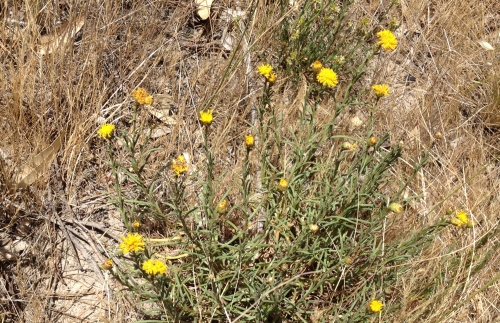
References & Links
- Briggs J.D., Corrigan V.T. and Smith, W.J.S. (1998) Rutidosis leptorrhynchoides (Button Wrinklewort) revised national recovery plan, 3rd ed, July 1998
- FIS (2005) Flora Information System, Department of Sustainability & Environment, Victoria.
- FFG Threatened List (2025) Flora and Fauna Guarantee Act 1988 - Threatened List - September 2025, Department of Energy, Environment and Climate Action (DEECA) , Victoria.
- Humpheries R., Webster A. (1992) Flora & Fauna Guarantee Action Statement No. 28 Button Wrinklewort, Department of Sustainability & Environment, Victoria.
- McIntyre S.; Lavorel S. (1994) How environmental and disturbance factors influence species composition in temperate Australian grassland, Journal of Vegetation Science, Volume 5, Issue 3 , 1994, Pages 373-384.
- Morgan J.W.(1995a) Ecological Studies of the Endangered Rutidosis leptorrhynchoides. I. Seed Production, Soil Seed Bank Dynamics, Population Density and their Effects on Recruitment, Aust. J. Bot., 1995,43,l-11
- Morgan J.W. (1999) Effects of population size on seed production and germinability in an endangered, fragmented grassland plant. Conservation Biology 13(1), 266-273
- Morgan John W. (2000) Reproductive Success in Reestablished versus Natural Populations of a Threatened Grassland Daisy (Rutidosis leptorrhynchoides). Conservation Biology 14 (3), 780-785. doi: 10.1046/j.1523-1739.2000.98516.x
- Morgan John W. & Scacco Paul J. (2006) Planting designs in ecological restoration: Insights from the Button Wrinklewort. Ecological Management & Restoration 7 (1), 51-54. doi: 10.1111/j.1442-8903.2006.00248.x
- Murray BG, Young AG (2001) Widespread Chromosome Variation in the Endangered Grassland Forb Rutidosis leptorrhynchoides F. Muell. (Asteraceae: Gnaphalieae), Annals of Botany 78 (1) 83-90, January 2001. doi: 10.1006/anbo.2000.1307
- VBA (2025) Victorian Biodiversity Atlas, Department of Energy, Environment and Climate Action (DEECA), Victoria.
- VVB (2025) Visualising Victoria's Biodiversity map portal.
- Walsh, N.G. & Entwisle, T.J. (1999) Flora of Victoria, Volume 4 – Dicotyledons, Cornaceae to Asteraceae. Inkata Press, Melbourne.
- Young A. G., Brown A. H. D. & Zich F. A. (1999) Genetic Structure of Fragmented Populations of the Endangered Daisy Rutidosis leptorrhynchoides. Conservation Biology 13 (2), 256-265. doi: 10.1046/j.1523-1739.1999.013002256.x
More Information
- Flora Fauna Guarantee Action Statement N. 28 pdf
- Button Wrinklewort - Species profile & threats database, Department of Climate Change, Energy, the Environment and Water (Australian Government)

